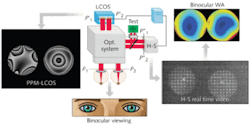Adaptive-optics (AO) technology is actively applied in the field of ophthalmology for diagnosis of retinal disease and analysis of ocular aberrations such as coma and spherical aberrations. Although most AO simulators were developed to study the impact of these aberrations in monocular vision, researchers at Universidad de Murcia (Murcia, Spain) have developed the first low-cost and relatively simple AO simulator that studies the effects of ocular aberrations in human binocular vision.1
According to the researchers, the binocular AO vision simulator is the first apparatus capable of measuring and manipulating the aberrations from the two eyes simultaneously; in addition, the setup can also manipulate the aberrations of each eye independently. Because the apparatus measures and manipulates the wavefront of each eye using a single wavefront sensor and a single AO correcting device, it is relatively simple to implement in a clinical setting.
The AO apparatus
Collimated light from a 780 nm pigtailed laser diode is sent through two spatially separated 1-mm-diameter pinholes and reflects off a beamsplitter toward a prism that routes the separate illumination points to two mirrors that direct the light onto the pupils of the two eyes under test. Light either reflected or backscattered from the retinas of each eye is sent back in a reverse path through the beamsplitter to a series of lenses and mirrors used for focus control. Within the beam path is a liquid-crystal-on-silicon (LCOS) spatial light modulator (SLM) from Hamamatsu Photonics (Hamamatsu City, Japan) used for wavefront correction. The LCOS SLM has a refresh rate of 60 Hz with 800 × 600 pixels, which corresponds to 58,000 independent pixels for controlling the wavefront of each pupil when the LCOS SLM aperture diameter is set to 4.8 mm. Light leaving the SLM is then sent through another set of lenses to conjugate the plane of the corrected image onto a Hartmann-Shack sensor with a 0.5 magnification.
The two pupils are spatially resolved on the single sensor, allowing the simultaneous measurement of the aberrations from each eye (see figure). With a sensor microlens pitch and focal length of 0.3 and 6 mm, respectively, more than 50 microlenses sample the incoming wavefront from each eye. A mathematical algorithm is used to convert the visual images to wavefront data that represent the aberration of each eye.
To test the efficacy of the simulator, stimuli for contrast-sensitivity measurements and other visual tasks were input to the eyes under test through an optical path (via another beamsplitter) between the LCOS SLM and the sensor. In one test case, a mildly myopic (-1.5 diopter) test subject was subjected to an additional amount of spherical aberration in each eye, from -0.2 to +0.2 µm, to study the effect of the aberration on the subject’s vision. Analysis showed that while contrast sensitivity was reduced more due to spherical aberration for the case of monocular vision compared to binocular vision, as expected, degradation in the binocular case was not symmetric.
“This type of adaptive-optics technology applied to simulate and test vision offers a tremendous future potential, not only to perform new research experiments, but to prescribe better optical solutions to patients,” said Pablo Artal, team leader for the project. “This research surely will pave the way to more-advanced future approaches to evaluate and correct vision in the general population.”
REFERENCE
- E. J. Fernández et al., Optics Letters 34(17) p. 2628 (Sept. 1, 2009).

